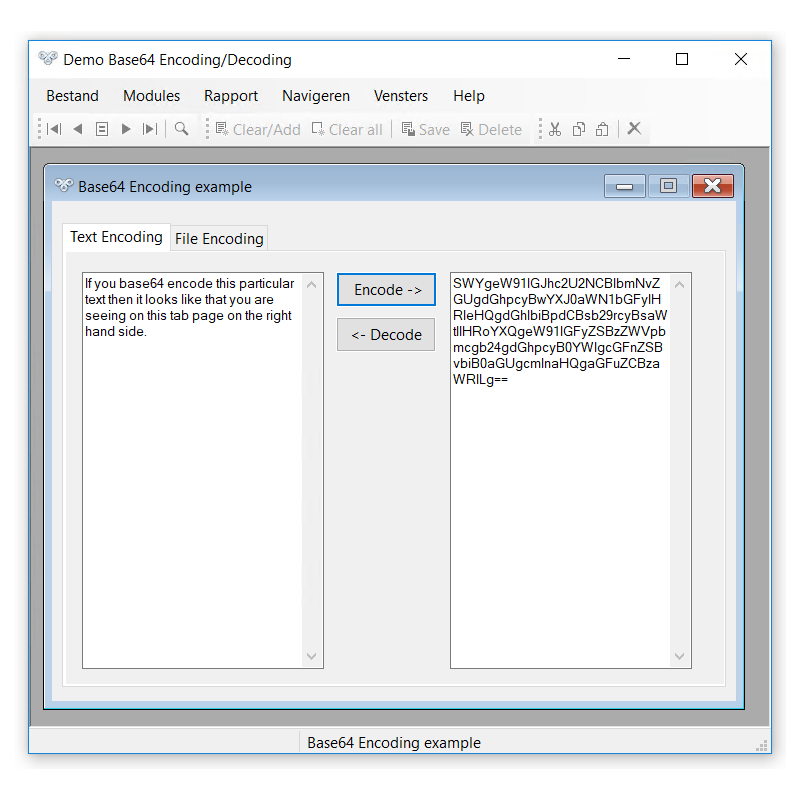




A DataFlex component for Base64 encoding/decoding on strings as well as files.
This component uses a standalone DLL to perform its base64 processing and does not depend on any other components in your system. It is a high performance way of adding base64 capabilities to your applications. It comes with a Visual DataFlex wrapper class and there's a demo application available for download for a quick evaluation.
For DataFlex versions up until DataFlex 18.0 use this demo workspace:
Download antBase64 Demo Workspace for DataFlex versions up until DataFlex 18.0
For DataFlex version 18.1 and higher use the following workspace (DataFlex 18.1+ has UChar array support and the wrapper class and demo uses it)
Download antBase64 Demo Workspace for DataFlex 18.1 and higher
The demo is fully functional, but has a "nag" dialog on first use.
All prices are including 21% VAT, non Dutch EU companies can get a bill without VAT after supplying a valid VAT tax number during the check out and ordering process.
VAT tax does not apply outside of the EU.
The product is normally send within one working day from the date of purchase.
A component for Base64 encoding/decoding strings and files.
This component uses a standalone DLL to perform its base64 processing and does not depend on any other components in your system. It is a high performance way of adding base64 capabilities to your applications.
The control comes with a Visual DataFlex wrapper class for ease of use.
What can you use it for?
If you have never used base64 encoding before then you might wonder what you would want to use this for. You can take a quick look at Wikipedia's definition for base64 encoding.
In short: base64 encoding is used as a standard way to transfer binary -or otherwise difficult to exchange- data from one system to another system using a known set of ascii characters[1]. It is often used for embedding binary data into XML or for example it is used in the MIME encoding of attachments to your email messages.
The base64 standard that has been implemented and which is supported by our control, is the standard as is defined in RFC 2045. This is the most commonly used base64 encoding. We have not seen requests for one of the alternatives, but do contact us if you need that.
This encoding is often used to exchange data between different types of systems and applications. You should have no problem exchanging your data with for example .net based applications or webservices that require the data to be base64 encoded.
[1]The known set of characters used for encoded data consists of:
| Value | Encoding | Value | Encoding | Value | Encoding | Value | Encoding |
| 0 | A | 17 | R | 34 | i | 51 | z |
| 1 | B | 18 | S | 35 | j | 52 | 0 |
| 2 | C | 19 | T | 36 | k | 53 | 1 |
| 3 | D | 20 | U | 37 | l | 54 | 2 |
| 4 | E | 21 | V | 38 | m | 55 | 3 |
| 5 | F | 22 | W | 39 | n | 56 | 4 |
| 6 | G | 23 | X | 40 | o | 57 | 5 |
| 7 | H | 24 | Y | 41 | p | 58 | 6 |
| 8 | I | 25 | Z | 42 | q | 59 | 7 |
| 9 | J | 26 | a | 43 | r | 60 | 8 |
| 10 | K | 27 | b | 44 | s | 61 | 9 |
| 11 | L | 28 | c | 45 | t | 62 | + |
| 12 | M | 29 | d | 46 | u | 63 | / |
| 13 | N | 30 | e | 47 | v | ||
| 14 | O | 31 | f | 48 | w | (pad) | = |
| 15 | P | 32 | g | 49 | x | ||
| 16 | Q | 33 | h | 50 | y |
Demo
There's a complete Visual DataFlex version 16.1 demo application available for download for a quick evaluation.
The only functional limitation in that demo is that it throws up a "nag" dialog on first use. It does come with all of the code required for use in developing your products.
License
There are no restrictions on usage or deployment for the control, but its use is limited for use by a single developer. You can use it for as many applications (Windows or Web) as you want after purchasing the component.
So to sum it up:
Unlimited applications.
Comes with a wrapper class for easy usage from within DataFlex.
Single developer seat.